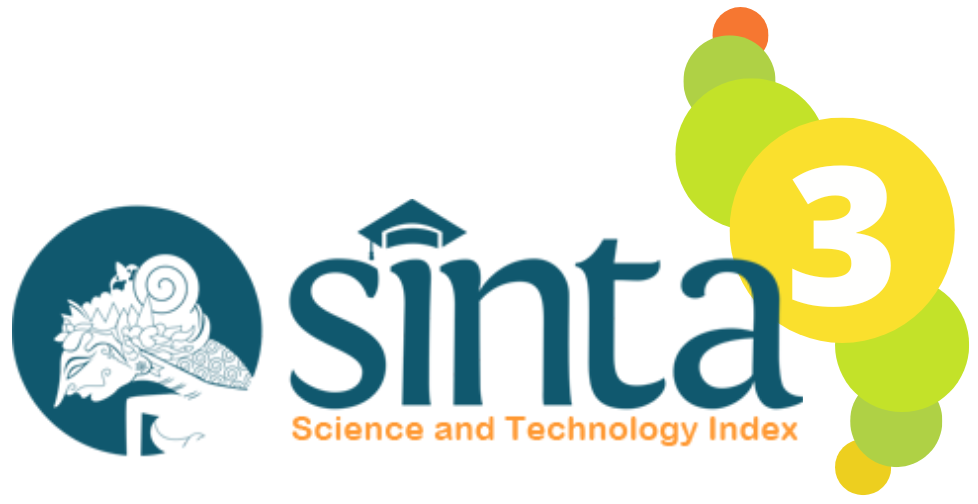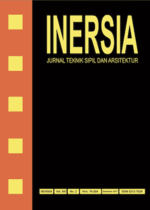Evaluation of Degree of Consolidation, Over Consolidation Ratio and Coefficient of Consolidation from CPTu tests in Alluvium Clays
DOI:
https://doi.org/10.21831/inersia.v19i2.58976Keywords:
soft soil, cptu, alluvium soilAbstract
Soft soil was found in several areas in Indonesia, one of them is in Kalimantan Island, which the soft soil in the island mostly formed by Alluvium. One of the characteristics of the soft soil is that they are likely still in under consolidating stage. The usage of CPTu was found to be suitable to the soft soil as the device can record small numbers continuously and able to record pore water pressure. Key features in performing CPTu in under consolidating soft soil is the dissipation test. However, often the dissipation test ended before the 50% excess pore pressure dissipated, which causes commonly used method for interpretation unable to estimate u50. Inverse time (Whittle et. al., 2000; Lim et. al., 2014) and inverse square root time (Liu et. al., 2014) method was developed to overcame the limitation. Rahardjo et. al. (2016) also developed method for obtaining degree of consolidation (and OCR) using pore pressure ratio parameter (Bq) obtained from CPTu. Geotechnical investigation comprised advancing several cone penetration testings (CPTu) were carried out after failure occurred in a relatively flat area (RL +5m to +12m) after having built waste dump embankment to +70m elevation. Soft soil with 15m to 30m thickness was found beneath the embankment. This paper presents comparison of coefficient of consolidation using Teh & Houlsby (1991) method using parameters derived from inverse time and inverse square root time, also comparison for degree of consolidation and OCR in the Alluvium clays based on the dissipation data obtained from the testings. Result showed that the Alluvium clays in the upper 10m already over consolidated while between RL 0 to -20m are still under consolidating, with parameters obtained using inverse time and inverse square root time generally showing close value.
References
T. Lunne, P. K. Robertson, and J. J. M. Powel, "Cone Penetration Testing A Historic Perspective - PDF Free Download," 1st Ed. London: E&FN SPON. Accessed: Dec. 31, 2023. [Online]. Available: https://docplayer.net/8734644-Cone-penetration-testing-a-historic-perspective.html
P. K. Robertson and K. L. Cabal, "Guide to Cone Penetration Testing for Geotechnical Engineering," California: Gregg Drilling Inc. Accessed: Dec. 31, 2023. [Online]. Available: https://www.researchgate.net/publication/370682668_CONE_PENETRATION_TESTING_GUIDE_TO
P. K. Robertson, "Evaluation of Flow Liquefaction and Liquefied Strength Using the Cone Penetration Test," Journal of Geotechnical and Geoenvironmental Engineering, vol. 136, no. 6, pp. 842–853, Nov. 2010, doi: 10.1061/(ASCE)GT.1943-5606.0000286.
P. P. Rahardjo and A. Arafianto, "CPTu in Ultra-soft and Very Soft Marine Clays and Silts in North Jakarta Coastal Area," International Symposium on Practical Applications of Ground Engineering for Embankmens on Soft Soils, GEESS2022. Malaysia. Accessed: Dec. 31, 2023. [Online]. Available: https://www.researchgate.net/publication/364734831_CPTu_in_Ultra-soft_and_Very_Soft_Marine_Clays_and_Silts_in_North_Jakarta_Coastal_Area
P. P. Rahardjo and E. F. Salim, "Interpretasi Parameter Tanah Lempung Lembek Berdasarkan Uji Piezocone," Proceeding of PIT HATTI VI.
P. P. , Rahardjo and E. F. Salim, "CPTu in Consolidating Soils," Proceeding 5th International Conference on Geotechnical and Geophysical Site Characterisation, ISC'5. Australia, 2016, Accessed: Dec. 31, 2023. [Online]. Available: www.tempo.com.
A. J. Whittle, T. Sutabutr, J. T. Germaine, and A. Varney, "Prediction and interpretation of pore pressure dissipation for a tapered piezoprobe," https://doi.org/10.1680/geot.2001.51.7.601, vol. 51, no. 7, pp. 601–617, May 2001, doi: 10.1680/GEOT.2001.51.7.601.
B. S. Lim, M. T. Tumay, J. W. Lee, B. S. Chun, and J. W. Jung, "A case study in evaluating the status of consolidation of a soft soil deposit by incomplete piezocone dissipation tests using laboratory and field data," Soils and Foundations, vol. 54, no. 4, pp. 648–656, Aug. 2014, doi: 10.1016/J.SANDF.2014.06.007.
S. Liu, J. Ju, G. Cai, and Z. Liu, "Stress History Estimation Method of Underconsolidated Soil by Partial Piezocone Dissipation Tests," Marine Georesources & Geotechnology, vol. 32, no. 4, pp. 368–378, 2014, doi: 10.1080/1064119X.2013.778376.
G. Cai, S. Liu, and A. J. Puppala, "Predictions of coefficient of consolidation from CPTU dissipation tests in Quaternary clays," Bulletin of Engineering Geology and the Environment, vol. 71, no. 2, pp. 337–350, May 2011, doi: 10.1007/S10064-011-0385-4.
S. G. Chung, H. J. Kweon, and W. Y. Jang, "Hyperbolic Fit Method for Interpretation of Piezocone Dissipation Tests," Journal of Geotechnical and Geoenvironmental Engineering, vol. 140, no. 1, pp. 251–254, Jan. 2014, doi: 10.1061/(ASCE)GT.1943-5606.0000967.
C. P. Krage, J. T. DeJong, and F. Schnaid, "Estimation of the Coefficient of Consolidation from Incomplete Cone Penetration Test Dissipation Tests," Journal of Geotechnical and Geoenvironmental Engineering, vol. 141, no. 2, Feb. 2015, doi: 10.1061/(ASCE)GT.1943-5606.0001218.
C. I. Teh and G. T. Houlsby, "An analytical study of the cone penetration test in clay," Geotechnique, vol. 41, pp. 17–34, 1991.
Y. Tanaka and T. Sakagami, "Piezocone testing in underconsolidated clay," https://doi.org/10.1139/t89-069, vol. 26, no. 4, pp. 563–567, 1989, doi: 10.1139/T89-069.
A. Arafianto, P. P. Rahardjo, and A. Lim, "Finite-Element Modeling of Cone Penetration in Soft Clay at South Bandung, West Java, Indonesia," International Journal of Geomechanics, vol. 21, no. 12, p. 04021227, Dec. 2021, doi: 10.1061/(ASCE)GM.1943-5622.0002175.
Y. Ansari, R. Merifield, and D. Sheng, "A piezocone dissipation test interpretation method for hydraulic conductivity of soft clays," Soils and Foundations, vol. 54, no. 6, pp. 1104–1116, Dec. 2014, doi: 10.1016/J.SANDF.2014.11.006.
L. BaÅ‚achowski, "Soft Soil Overconsolidation and CPTU Dissipation Test," Archives of Hydro-Engineering and Environmental Mechanics, vol. 53, no. 2, pp. 155–180, 2006.
G. Cai et al., "Prediction of the Coefficient of Consolidation of Soil via the Hyperbolic Fitting Method during Piezocone Dissipation Test," International Journal of Geomechanics, vol. 20, no. 10, Oct. 2020, doi: 10.1061/(ASCE)GM.1943-5622.0001813.
J. Chai, D. Sheng, J. P. Carter, and H. Zhu, "Coefficient of consolidation from non-standard piezocone dissipation curves," Comput Geotech, vol. 41, pp. 13–22, Apr. 2012, doi: 10.1016/J.COMPGEO.2011.11.005.
Y. X. Lim, S. A. Tan, and K. K. Phoon, "Interpretation of horizontal permeability from piezocone dissipation tests in soft clays," Comput Geotech, vol. 107, pp. 189–200, Mar. 2018, doi: 10.1016/J.COMPGEO.2018.12.001.
Y. Zhang, X. Feng, S. Deng, C. Ding, and T. Liu, "Pore Pressure Response and Dissipation of Piezocone Test in Shallow Silty Soil of Yellow River Delta," Journal of Marine Science and Engineering 2022, Vol. 10, Page 255, vol. 10, no. 2, p. 255, Feb. 2022, doi: 10.3390/JMSE10020255.
J. P. Sully, P. K. Robertson, R. G. Campanella, and D. J. Woeller, "An approach to evaluation of field CPTU dissipation data in overconsolidated fine-grained soils," Canadian Geotechnical Journal, vol. 36, no. 2, pp. 369–381, 1999, doi: 10.1139/CGJ-36-2-369.
Downloads
Published
How to Cite
Issue
Section
License
Authors who publish with INERSIA journal agree to the following terms:
- Authors retain copyright and grant the INERSIA journal right of first publication with the work simultaneously licensed under Creative Commons Attribution License (CC BY 4.0) that allows others to share the work with an acknowledgment of the work's authorship and initial publication in this journal.
- Authors can enter into separate, additional contractual arrangements for the non-exclusive distribution of the published version of the work (e.g., post it to an institutional repository or edit it in a book), with an acknowledgment of its initial publication in this journal.
- Authors are permitted and encouraged to post their work online (e.g., in institutional repositories or on their website) before and during the submission process, as it can lead to productive exchanges, as well as earlier and greater citation of published work.

INERSIA by https://journal.uny.ac.id/index.php/inersia was distributed under a Creative Commons Attribution 4.0 International License











